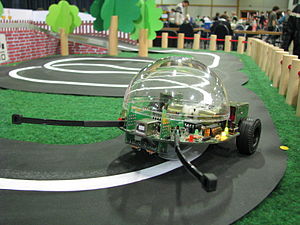NIBObee
| NIBObee | |
|---|---|
 |
|
| Type | autonomous mobile robot |
| Kit | |
| Manufacturer | nicai-systems |
| publication | 2009 |
| Technical specifications | |
| Actuators | 2 drive wheels, 7 LEDs |
| Sensors | 2 incremental rotary encoders, 3 IR floor sensors, 2 sensors |
| computer | ATmega16 |
| connections |
USB |
| energy | 4 micro (AAA) batteries |
| measures and weight | |
| Dimensions (H × W × D) | 78 × 131 × 136 mm |
| Weight | 544 g |
NIBObee is a kit for an autonomous mobile robot of the same name that can be programmed in C , C ++ , Java and assembler . It was developed in 2009 specifically for use in the training sector.
construction
The robot has two wheels for locomotion . Each wheel has a motor, a gearbox and an incremental encoder to measure the movement of the wheel. In addition, the NIBObee is able to detect obstacles such as B. to recognize walls. In addition, the robot can measure the brightness of the ground with 3 infrared sensors. B. to trace a line.
In addition to the kit, you need a soldering iron , solder and batteries for assembly . For beginners, it is advantageous that no surface-mounted components (SMD) but only wired components are used. The ICs are also all socketed.
programming
The NIBObee uses an Atmel AVR microcontroller as the processor (an ATmega16 in the standard scope of delivery , with appropriate extensions up to the ATmega1284 ), which can be programmed via a built-in USB port. The USB connection is provided by a second, fully programmed controller. The batteries can also be charged through the USB port. Programs can be written in a variety of languages including C, C ++, Java, and Assembler.
Various ready-made programs are freely available to try out and continue writing, e.g. B. Programs for line tracking, obstacle avoidance and various flashing programs. The example programs are written for the AVR-GCC . It is even possible to make music with the drive motors through clever programming.
use
The NIBObee is mainly used in educational institutions, as soldering, assembly and hardware-related programming can be learned easily and playfully with it.
Extensions
The range of functions of the NIBObee can be expanded using appropriate expansion kits from nicai-systems. LEDs for running lights, an extended obstacle detection system (via further IR LEDs) or a remote system that works via infrared, with which the NIBObee can be controlled via IR remote controls, can be installed on an extension board. A graphic display or a tuning kit, with which the NIBObee gets more power, and a Bluetooth control that works via a corresponding Android app, can also be purchased.
Features
- Main processor: ATmega16, 16 kByte Flash, 15 MHz
- Controller for programming via USB: ATtiny44, 4kByte Flash, 15MHz
- Sensors: 2 sensors with 4 buttons
- Actuators: 2 motors with 1:25 ratio
- Odometry: 2 IR sensors for speed
- Line sequence sensors: 3 photo transistors with 2 IR LEDs on a separate board
Other kit robots
Web links
- description
- NIBObee Library project at Source Forge
- Alternative library and suggestions for expansion
swell
- http://www.elektor.de/elektronik-news/neuer-roboterbausatz-nibobee-in-cc-java-und.1186843.lynkx
- http://www.nicai-systems.com/nibobee.html?lang=de# Zubehör
Individual evidence
- ↑ Play Bach! - Program for creating music
- ↑ http://www.nicai-systems.com/nibobee.html?lang=de# Zubehör - accessories